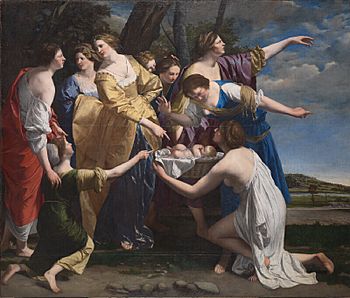The Finding of Moses (Orazio Gentileschi) facts for kids
Quick facts for kids The Finding of Moses |
|
|---|---|
 |
|
| Artist | Orazio Gentileschi |
| Year | early 1630s |
| Medium | Oil on canvas |
| Dimensions | 257 cm × 301 cm (101 in × 119 in) |
| Location | National Gallery, London |
The Finding of Moses is a famous painting created by an artist named Orazio Gentileschi in the early 1630s. This artwork shows a scene from the Bible where the baby Moses is found in a basket. There are two main versions of this painting. One is kept at The National Gallery in London, and the other is in the Museo del Prado in Madrid.
The London Painting
This version of The Finding of Moses was bought by a private art collector in 1995. A private collector is someone who owns art for themselves, not for a museum. In 2002, the painting was placed on a long-term loan to the National Gallery. This means the gallery could display it for many years.
After almost 20 years, the National Gallery was able to buy the painting. They purchased it for £22 million in December 2019.
This painting was originally ordered by King Charles I. He wanted it for his wife, Henrietta Maria. It was a gift to celebrate the birth of their son and future king, Charles II. The painting was made for the Queen's House in Greenwich, a royal building. Once it was finished, it hung in the Great Hall.
After King Charles I passed away, the painting was sent back to his wife in France in 1660. Later, it became part of the Orleans Collection, a famous group of artworks. For a while, people thought the painting was by a different artist, Velázquez. However, once Gentileschi's second version in the Prado museum became known in England, experts realized who the true artist was.
The Madrid Painting
The other version of The Finding of Moses is now in the Prado museum in Madrid, Spain. This painting was created in 1633. Many art experts believe it is a copy made by Gentileschi himself. He painted it after his earlier London version.
The artist created this painting for King Philip IV of Spain. He sent it to the king as a gift in the summer of 1633. Gentileschi's son, Francesco Gentileschi, personally delivered the painting to King Philip in Madrid.
In October of that same year, Arthur Hopton wrote about the painting. He was the English ambassador to Spain at the time. He mentioned that the painting had been hung in the Salón Nuevo, a special room in the Royal Alcázar of Madrid. King Philip was very happy with the artwork. He approved a payment of 900 ducats to the artist. A ducat was a type of gold coin used as money back then.


